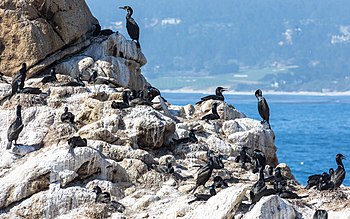
Back مستعمرة (أحياء) Arabic Orqanizmlərin koloniyası Azerbaijani कॉलोनी (जीव बिज्ञान) Bihari Colònia (biologia) Catalan Kolonie (biologie) Czech Kolonie (Biologie) German Αποικία (μικροβιολογία) Greek Kolonio (biologio) Esperanto Colonia (biología) Spanish Koloonia (bioloogia) Estonian

In biology, a colony is composed of two or more conspecific individuals living in close association with, or connected to, one another. This association is usually for mutual benefit such as stronger defense or the ability to attack bigger prey.[1]
Colonies can form in various shapes and ways depending on the organism involved. For instance, the bacterial colony is a cluster of identical cells (clones). These colonies often form and grow on the surface of (or within) a solid medium, usually derived from a single parent cell.[2]
Colonies, in the context of development, may be composed of two or more unitary (or solitary) organisms or be modular organisms. Unitary organisms have determinate development (set life stages) from zygote to adult form and individuals or groups of individuals (colonies) are visually distinct. Modular organisms[3] have indeterminate growth forms (life stages not set) through repeated iteration of genetically identical modules (or individuals), and it can be difficult to distinguish between the colony as a whole and the modules within.[4] In the latter case, modules may have specific functions within the colony.
In contrast, solitary organisms do not associate with colonies; they are ones in which all individuals live independently and have all of the functions needed to survive and reproduce.
Some organisms are primarily independent and form facultative colonies in reply to environmental conditions while others must live in a colony to survive (obligate). For example, some carpenter bees will form colonies when a dominant hierarchy is formed between two or more nest foundresses[5] (facultative colony), while corals are animals that are physically connected by living tissue (the coenosarc) that contains a shared gastrovascular cavity.
- ^ Jackson, J.B.C. (1977). "Competition on Marine Hard Substrata: The Adaptive Significance of Solitary and Colonial Strategies". The American Naturalist. 111 (980): 743–767. doi:10.1086/283203. S2CID 84687243.
- ^ "Colony – Biology-Online Dictionary". www.biology-online.org. Retrieved 2017-05-06.
- ^ Hiebert, Laurel S.; Simpson, Carl; Tiozzo, Stefano (2020-04-19). "Coloniality, clonality, and modularity in animals: The elephant in the room" (PDF). Journal of Experimental Zoology Part B: Molecular and Developmental Evolution. 336 (3): 198–211. doi:10.1002/jez.b.22944. ISSN 1552-5007. PMID 32306502. S2CID 216030034.
- ^ Begon, Michael; et al. (2014). Essentials of Ecology (4th ed.). Wiley. ISBN 978-0-470-90913-3.
- ^ Dunn, T.; Richards, M.H. (2003). "When to bee social: interactions among environmental constraints, incentives, guarding, and relatedness in a facultatively social carpenter bee". Behavioral Ecology. 14 (3): 417–424. doi:10.1093/beheco/14.3.417.